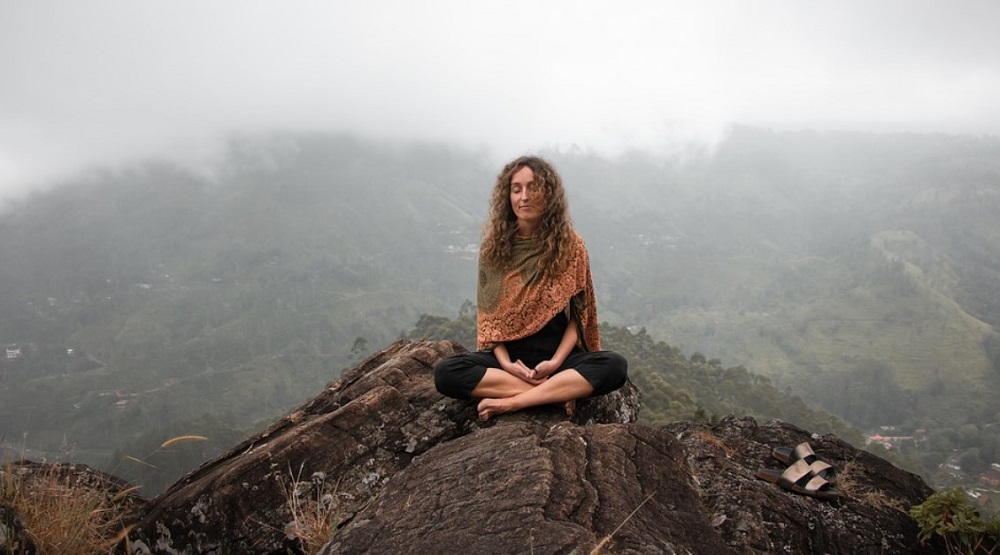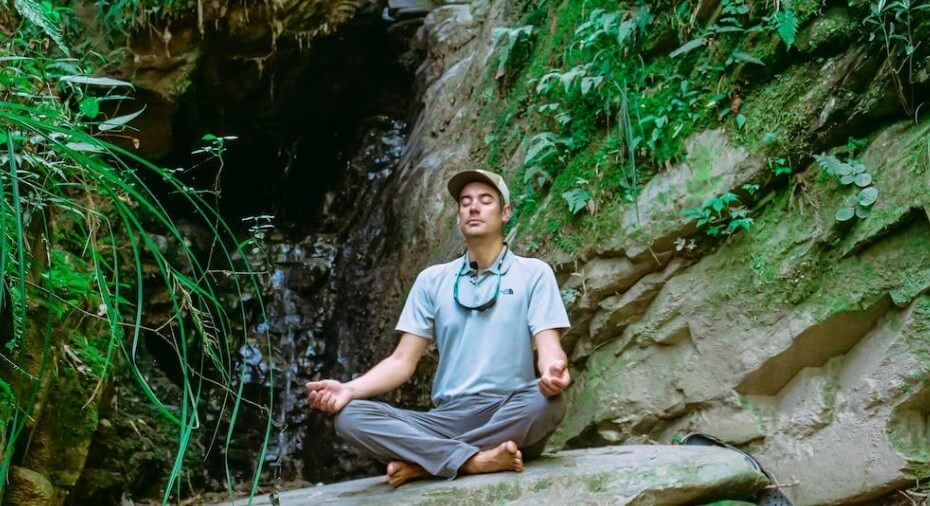If you’ve tried quieting your mind amidst all the bustle of the city, you’ll be quick to agree that the chaotic atmosphere of the urban environment doesn’t lend itself well to meditation. Thankfully, you can escape all the noise and enjoy peace and quiet when meditating in nature.
In this guide, we’ll share some tips to help you find quiet nature spaces to practice meditation and relaxation.
But first, why should you leave the safety and comfort of your home to meditate in the open? Are they any special benefits to meditating in nature?
Let’s find out.
Benefits of Meditating in Nature
Meditation offers plenty of benefits, but doing the same practice in nature takes these benefits to a whole new level.
One 2019 study of 20,000 people found that spending at least two hours a week in nature (either spaced over several visits or all at one time) can provide significant physical health benefits like stress reduction and speeding up healing.
But beyond improving your health, spending time surrounded by nature’s beauty and peacefulness increases your sense of calm, allowing you to release tension and relax.
And taking a break from the noise of modern living (hello, social media notification!) to bask in the tranquility of nature can help improve your focus and concentration, leading to increased productivity.
Also, meditating in nature allows you to become more aware of your environment ― the sounds, smells, and sensations of being in a natural environment. Besides deepening your reverence and appreciation for nature, this allows you to connect with your environment and improve your ability to live in the here and now.
How to Find Quiet Nature Spaces for Relaxation and Meditation

To be clear, there’s nothing wrong with meditating at home. In fact, we share some great ideas for creating the perfect meditation room in this post.
However, the constant noise of modern living can make relaxation and meditation quite challenging if you’re smack in the middle of a busy city.
And while noise-cancellation earphones can block out the constant hum of traffic, meditating indoors doesn’t give you access to nature’s abundant sounds, smells, and beauty ― elements that can enhance the overall experience.
Here are some tips to help you find quiet spaces in nature to relax and meditate.
Look for Secluded Areas
Less popular locations are some of the best spots for meditating in nature. While they may be beautiful and have plenty of natural elements, popular nature spaces are often crowded and filled with distractions.
This means you are more likely to find a secluded area with fewer people at less popular beaches, parks, or trails.
Ask Locals
You can ask family, friends, or coworkers who enjoy spending time in nature. They may be able to suggest a few hidden spots that are relatively undisturbed. Be sure to inspect the locations for suitability before scheduling your relaxation practice.
Research Online
Leverage the power of search engines to find areas near you known for their peacefulness and natural beauty. Look up hiking trails, nature reserves, and parks in your area.
Search for nature meditation retreats or local meditation groups that meditate in nature. They will likely know of quiet nature spaces where you can meditate without distractions.
Timing Is Everything
Sometimes, even the most serene nature spaces might not be well-suited for relaxation and meditation during certain times or days. You want to carefully plan your visit to have the best experience.
Consider visiting your preferred nature spots during the early morning hours or late afternoon, and plan to visit during weekdays rather than weekends. It’s usually quieter at these times and days, so you’re more likely to be able to enjoy your spiritual practice.
Top 7 Nature Spaces for Meditation

1. Near Water Bodies
Meditating near quiet lakeshores, beaches, rivers, and waterfalls can feel like an otherworldly experience, especially when you find a tranquil spot to meditate for longer periods.
Besides fostering a greater connection with the natural environment, listening to the relaxing sound of water as it cascades down a waterfall or softly gurgles as it flows through narrow crevices can help you go deep within and tap into the wisdom of your higher self.
2. Mountains
Mountains are a great place to meditate in nature. Set up in a spot with a stunning view and let the beauty of nature envelope you as you quiet your mind in meditation.
3. Hot Springs
The warm, nourishing waters of hot springs offer some of the best soothing environments to relax, let go, and meditate.
Find a hot spring in a scenic area surrounded by natural beauty, and practice some healing meditation when the area has little to no visitors.
Looking to take your relaxation a step further? Soak in the calming, mineral-rich water. Here’s a quick caveat, though. You want to be absolutely sure it’s safe before taking a dip.
Several studies suggest that soaking in hot springs has physical health benefits, and there is quite a number of anecdotal evidence claiming that hot potting helps remove bad omens and attract success. A 2022 study published in the Journal of Veterinary Medical Science reveals that hot spring bathing can speed up wound healing.
4. Forests
The fresh air, abundant shades, and gentle sound of rustling leaves make the forest an excellent place for meditation. Sit or lie under a tree, and let the peacefulness gently carry you into deep relaxation.
5. Canyons
If you prefer to meditate in an enclosed space in nature, scout out a safe spot in a canyon to spend some quiet time.
Thanks to their natural formations ― the sound of flowing water, echoing bird calls, and rustling leaves ― canyons often provide a unique and calming atmosphere with relaxing nature sounds well-suited for meditation.
In addition to providing a sense of shelter and protection, the walls in canyons provide privacy, allowing you to relax and meditate without worrying about passersby.
6. Parks and Nature Reserves
There are various natural environments in national and city parks, with many providing secluded areas well-suited for meditation and relaxation. You can also find designated quiet zones at some nature reserves where you can focus inward without external disturbances.
7. Curated Gardens
Sometimes, going into the woods to meditate can be quite challenging when you live in the city. But that doesn’t mean you can’t escape the noise of modern living to enjoy some peace and quiet.
You can visit a botanical garden, Japanese garden, arboretum, or any green space in the city for some quiet time.
Find a secluded spot in a peaceful, serene garden, and let the tranquility help you find inner peace.
Tips for Meditating in Nature

Sitting or lying in the open with your eyes closed and trying to focus can feel a bit awkward the first few times. You might feel somewhat “exposed” or unsafe, especially if you’re used to meditating indoors.
The feeling is normal and should go away after a couple of relaxation sessions. That said, here are a few tips to help you get the most out of your quiet time in nature.
- Find a safe spot to relax and meditate. While connecting with your higher self in nature offers plenty of benefits, you want to be aware of any potential risks or hazards when visiting some quiet nature spaces and take proper precautions. Before you start your session, check the area for falling rocks, uneven terrains, unstable grounds, and wild creatures. Also, look out for sudden weather changes.
- If the idea of sitting cross-legged alone in an unfamiliar environment makes you feel a bit apprehensive, consider joining a group that meditates in nature. Alternatively, you can meditate with a friend.
- When you find a quiet spot, take a few moments to bask in the sensations that come from being in that environment. Notice the sound of the wind in the trees, rustling leaves, flowing waters, or birds chirping. Take in the beauty of the natural environment ― the smells, colors, shapes, and textures. Connect as much as you can with your surroundings before starting your meditation session.
- Remember to wear comfortable clothing and bring a cushion or blanket to sit or lie on. And if you’re completely new to the practice, you might want to use guided meditation to reduce mind wandering and help you stay connected to the ever-present source of inspiration within.
- Lastly, follow all safety guidelines and rules when meditating in parks or nature reserves. Remember to be respectful of nature ― avoid disturbing wildlife, clean up whatever you bring, and make sure you leave no trace.
Enjoy the Incredibly Rewarding Experience of Meditating in Nature
Finding a quiet nature space to relax and meditate can help you connect with the essence of the natural environment and tap into infinite wisdom that may otherwise be inaccessible in a noisy urban setting.
From the breeze gently caressing your skin to the sweet smell of nature wafting through the air and the natural sounds surrounding you, immersing yourself in nature’s beauty can help ground you in the present moment, improve your focus, and reduce your overall stress levels.


